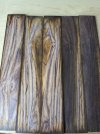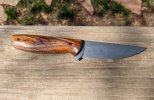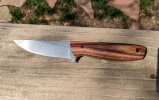Its colobolo. That color is something i have found in newer stock.
My personal theory that I cant technically prove is based on something i learned buying woods from the tropics.
Scientific names are just ideas, in the jungle you cut what looks right. I have been working with exotics for a long time, and I can ID the diffrence between Mexican or guatamalean cocobolo, or between Amazon and Honduras rosewood but msot people simply cant. Places like Rockler, wood craft and the like routinely have one marked as the other or any combination there in. Up until somewhat recently, what is today called Mexican kingwood, AKA Dalbergia Congestiflora was regularly sold as "Purple cocobolo" and listed as Dalbergia Retusa. In my reading and speaking with supplier and lumber collectors who work in the highlands, there is a huge variation. Most of them have not been categorized or listed as different but they grow in slightly different habitat and look different.
In my experience, the type of cocobolo shown above is Guatemalan cocobolo, the paleish color that will darken to fire orange. If you want the figure to show up faster, wipe a thin layer of mineral oil on the surface and expose it to sunlight for about 4 hours.
This species discription, where all the woods that look mostly the same get called the same thing in the western market is very common. Is a wood red? Call it Bloodwood, thats a way cooler name that americans will respond too better than Sateen. Is the wood fine grained and a lil shiny? Call it a Satinwood! Is it blacK? Call it an ebony! Did you find a wood thats slightly different from a wood with a desirable and marketable name? Just say its that wood!
I dont participate in this because it feels dishonest, but for instance I have lots of rare desert acacias like Miniritchie and Black Mulga, or Broken hill gidgee. They are great woods, but i feel the pull to just list them as "Ringed gidgee" because thats what people are searching for, thats what customers have seen and say that they want.
Sorry about the additional rant, but yes. You have cocobolo but its slightly diffrent than the orange + Black colored gidgee harvested in Mexico, to bring out the bright colors a little finish and sunlight will do.






